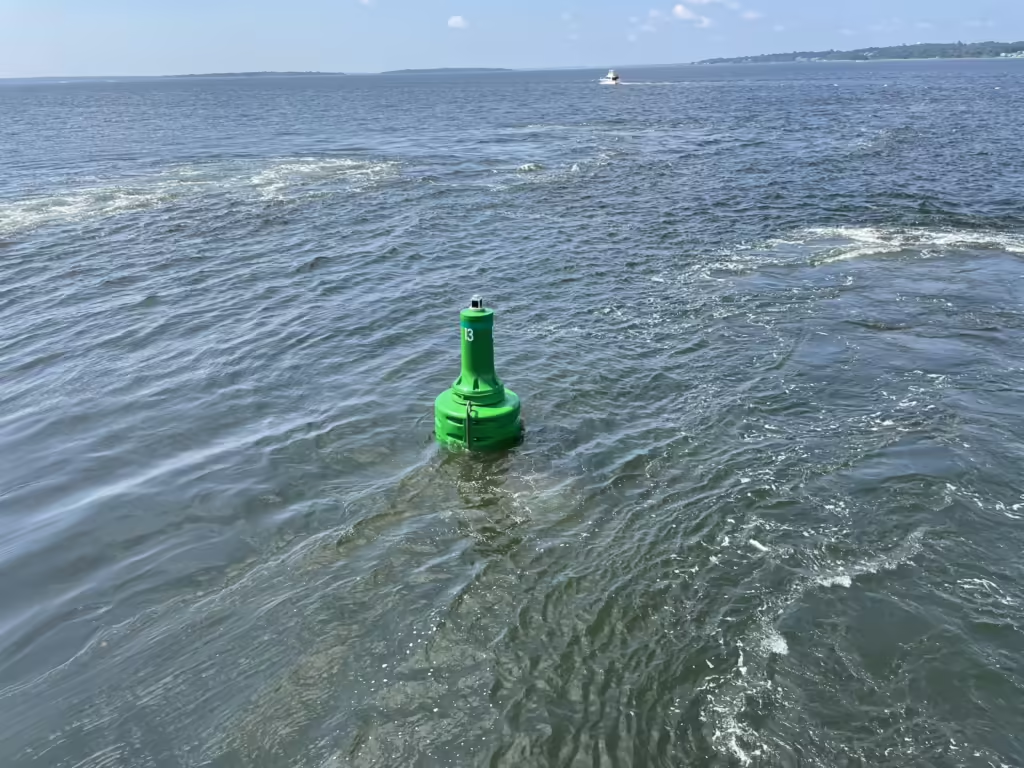Coast Guard & Lighthouse Authorities
Since its establishment in 1998, Tidal Marine has been at the forefront of marine navigation technology, becoming a trusted supplier for the Canadian Coast Guard and other maritime authorities worldwide. Our partnership with Carmanah Technologies led to the pioneering introduction of the first LED lanterns, revolutionising marine navigation safety.
By 2006, Tidal Marine had introduced modern, low-maintenance navigation buoys, specifically designed to meet the rigorous demands of the Canadian Coast Guard. These buoys are tailored to provide exceptional performance in varying current and wave conditions and are a testament to our commitment to quality and innovation. The company is an Industrial Member of the International Association of Lighthouse Authorities (IALA) and a member of the Engineering Committee.
Our Contributions and Innovations

Pictured above are Tidal Marine 1.50M SKIRT buoys deployed by US Coast Guard Cutter Ida Lewis in Rhode Island.
The Coast Guard Cutter Ida Lewis, a 175-foot “Keeper Class” coastal buoy tender, embodies our respect for maritime heritage. Named after the renowned lighthouse keeper Idawalley Zorada Lewis, this vessel signifies the valour and dedication of countless individuals in maritime safety.
Homeported in Newport, Rhode Island, the vessel’s area of responsibility extends from Long Island Sound, New York, to Cape Cod, Massachusetts.

Sustainability and Design
Our latest modular navigation buoys, developed initially for the Canadian Coast Guard in 2015, are made with high-density polyethylene that ensures a lifespan of at least fifty years.
Sustainability, form, fit and function were at the heart of the design when asked to replace the legacy Coast Guard 4’ 6” steel skirt buoys. These buoys are not only durable but also designed with a focus on reducing environmental impact. By replacing almost 300 legacy steel buoys with our modern designs, we have eliminated the need for sand-blasting and painting, significantly reducing CO2 emissions and resource use.
The high-density polyethylene core structure, boasting a useful life of at least fifty years, supports a 50m² (avg) radar reflector designed for reuse throughout the buoy’s lifespan. Additionally, the stainless steel lifting arms will be reused in the first refit after 12-15 years, coinciding with the replacement of the floats and tower.
Introduction of Modern Modular Navigation Buoys
The Canadian Coast Guard has replaced almost 300 legacy steel 4’ 6” diameter skirt navigation buoys with modern, low-maintenance modular navigation buoys across all regions of Canada. These buoys are 100% recyclable and eliminate the need for sand-blasting and painting, making them the best design from a sustainability perspective; 75% of the components will be reused in refits. The high-density polyethylene core is designed to last at least 50 years and requires no maintenance, while the modular design allows the radar reflector to be easily removed and reinstalled in a replacement tower during refit. The stainless steel lifting/mooring arms, made from 316L stainless steel, are also reusable at the first refit after 12-15 years.
Although the buoys use long-life IALA compliant, colour-fade-resistant pigments in the hull and tower manufacture, they will eventually need replacement due to long-term UV exposure. Fortunately, this long-life polyethylene is one of the easiest and most commonly recycled materials, driven by global demand for this type of reprocessed polyethylene in many applications. Tidal Marine welcomes the return of our buoys for 100% recycling, as the resulting re-processed polyethylene resin is directly used in our “ECO-AQUA” line of marine flotation products, which are outside of the critical AtoN buoy offering.
Our collaboration extends beyond borders, with notable projects like the one with the U.S. Coast Guard’s District 9. In an effort to innovate and improve sustainability, Tidal Marine developed the 0.80m Four Season Buoy. This buoy proved to be a year-round solution, eliminating the need for seasonal exchanges and reducing operational stress and environmental impact.